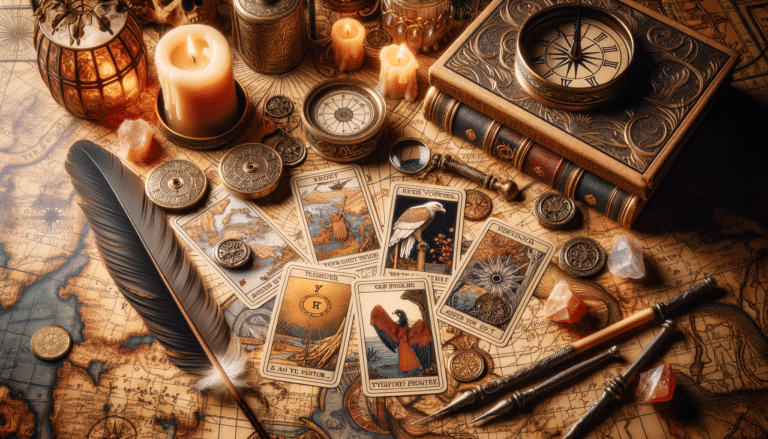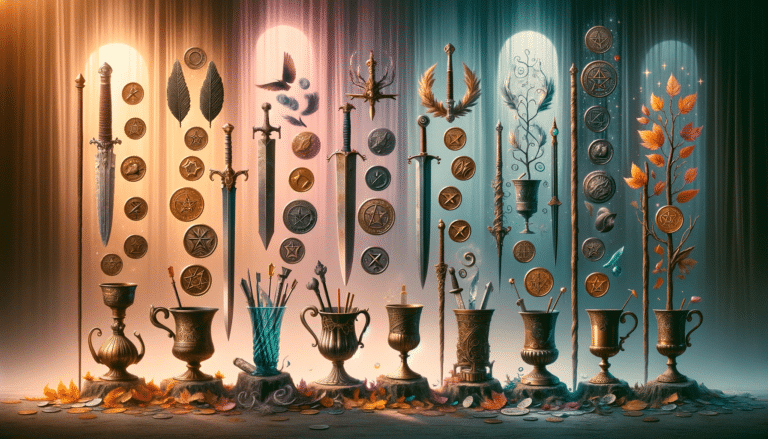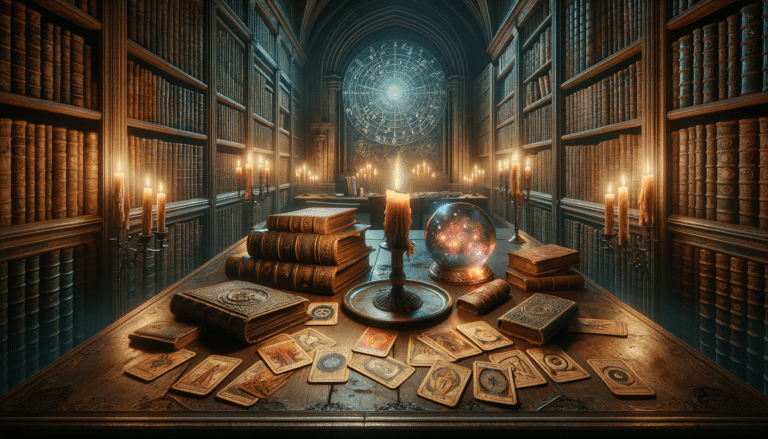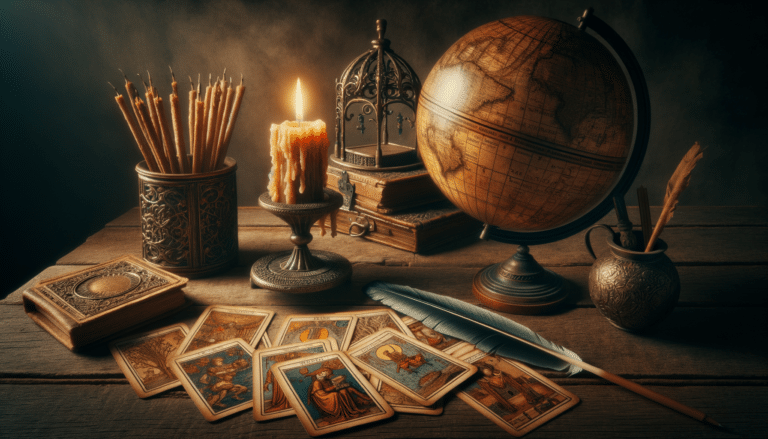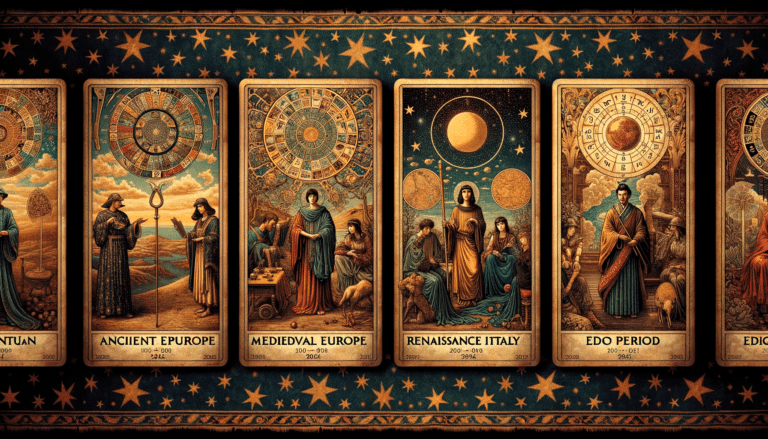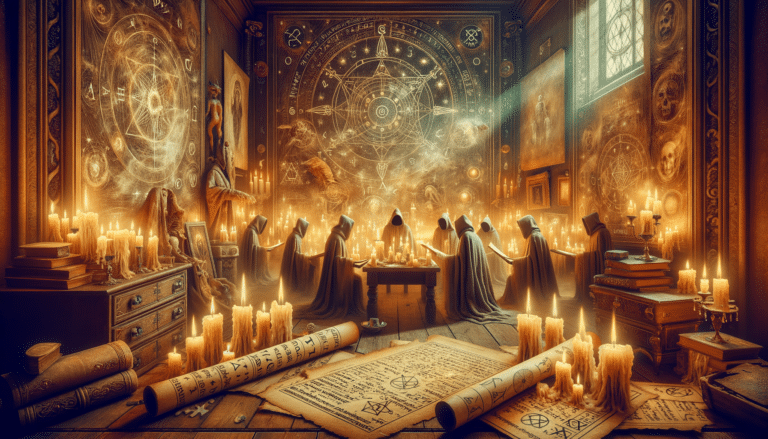Top 7 Displays of Ancient Mythology in Tarot History
Have you ever pondered if the captivating images on tarot cards are more than just random designs?
They’re not random. Not at all.
In fact, the rich tapestry of ancient mythology is woven deeply into the history of tarot.
As you delve into the 7 best examples of this integration of ancient mythology in tarot history, you’ll discover how the Fool’s journey mirrors your own life’s quest, and how Egyptian gods subtly influence the cards you draw.
You’ll see the might of Greek myths in the Chariot and feel the romance of Roman lore in The Lovers. You’ll uncover the hidden connections between Norse runes and tarot, explore the Celtic wisdom spinning within The Wheel, and encounter Hindu deities that dance through The World.
Unlock the secrets of these ancient narratives and enhance your understanding of tarot’s timeless wisdom.
Key Takeaways
- The Fool’s Journey archetype mirrors the hero’s odyssey found in ancient mythologies and represents a transformative process of self-discovery and personal growth.
- Egyptian deities like Thoth, Isis, and Anubis have left a significant mark on the Tarot’s history, with the Thoth Tarot deck incorporating Egyptian mythology and deities into its cards.
- Isis symbolizes resurrection and transformation through the Osirian cycle and embodies the nurturing aspect of the divine feminine, while Anubis symbolizes protection, transition, and guides souls through the afterlife.
- Greek and Roman mythology are intertwined with certain tarot cards, such as the Chariot card representing conquest and success with influences from Hercules, Apollo, and Poseidon, and the Lovers card reflecting themes of choice and partnership with connections to Cupid and Roman marriage customs. Norse and Celtic influences are also present in tarot, with Norse runes adding depth and layers of interpretation to the cards and the Wheel of Fortune card reflecting Celtic mythology and the cyclical nature of life with influences from Ogham symbols and Druidic practices.
The Fool’s Journey Archetype
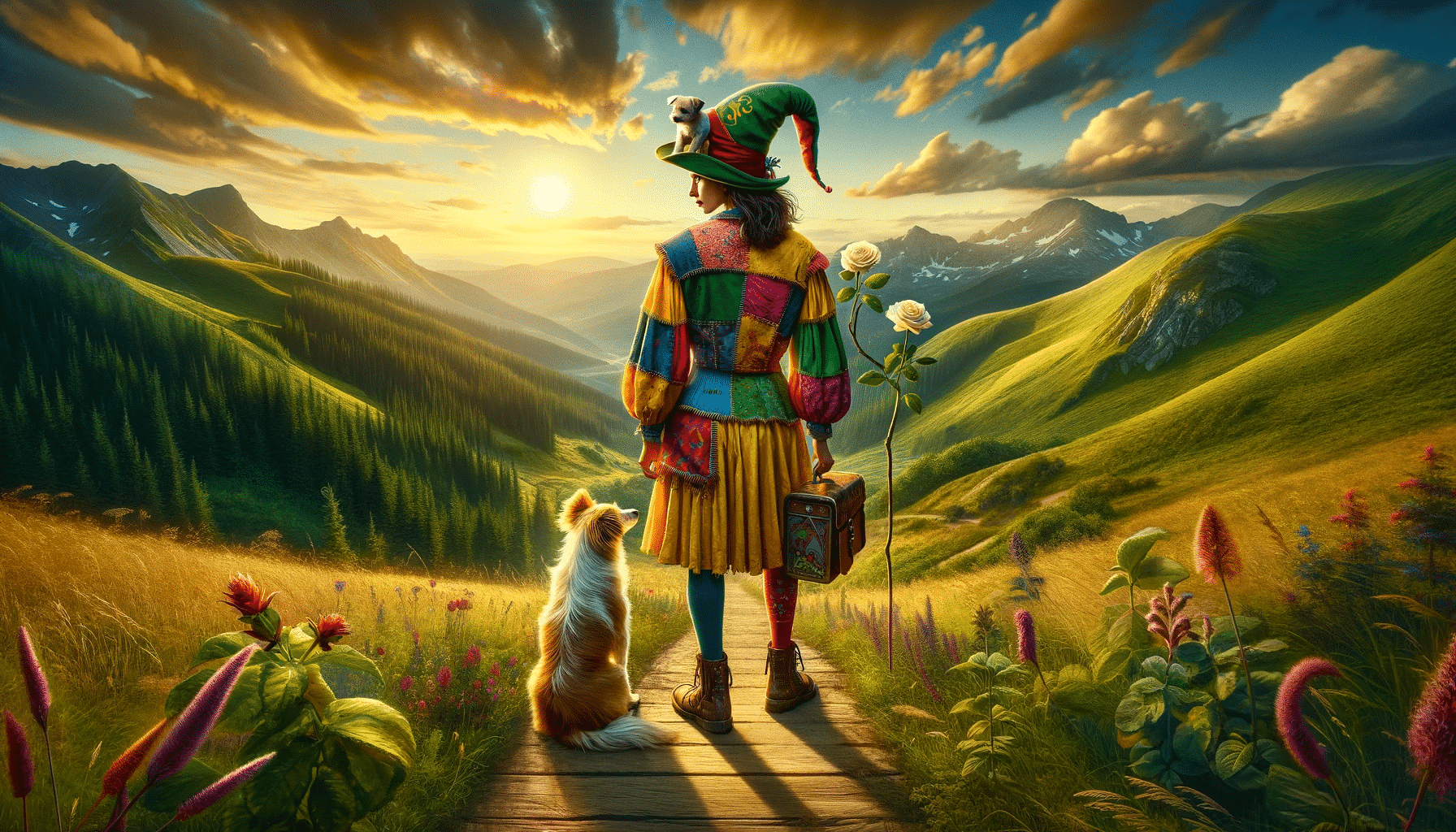
You’ll come across the Fool’s Journey archetype, a vital narrative framework in tarot that mirrors the hero’s odyssey found in ancient mythologies. This symbolic pathway highlights the personal quest we all undertake, akin to those epic tales of old where heroes ventured through trials to achieve enlightenment or fulfill their destiny.
In your exploration of tarot, you’ll recognize the Fool as the main character embarking on this life-altering journey. Just as Odysseus or Gilgamesh faced their own heroic odysseys, the Fool represents you or someone else stepping into the unknown, eager for growth and understanding. Each card the Fool encounters along the way symbolizes a different lesson or challenge, contributing to their overall development.
You’ll find that this journey isn’t just about reaching a destination; it’s a transformative process. It’s about the personal quest for self-discovery and the wisdom gathered from each triumph and setback.
As you delve deeper into the tarot, you’ll see how these archetypal stories resonate with your own experiences, providing insights that are both timeless and profoundly personal.
Egyptian Gods in Tarot
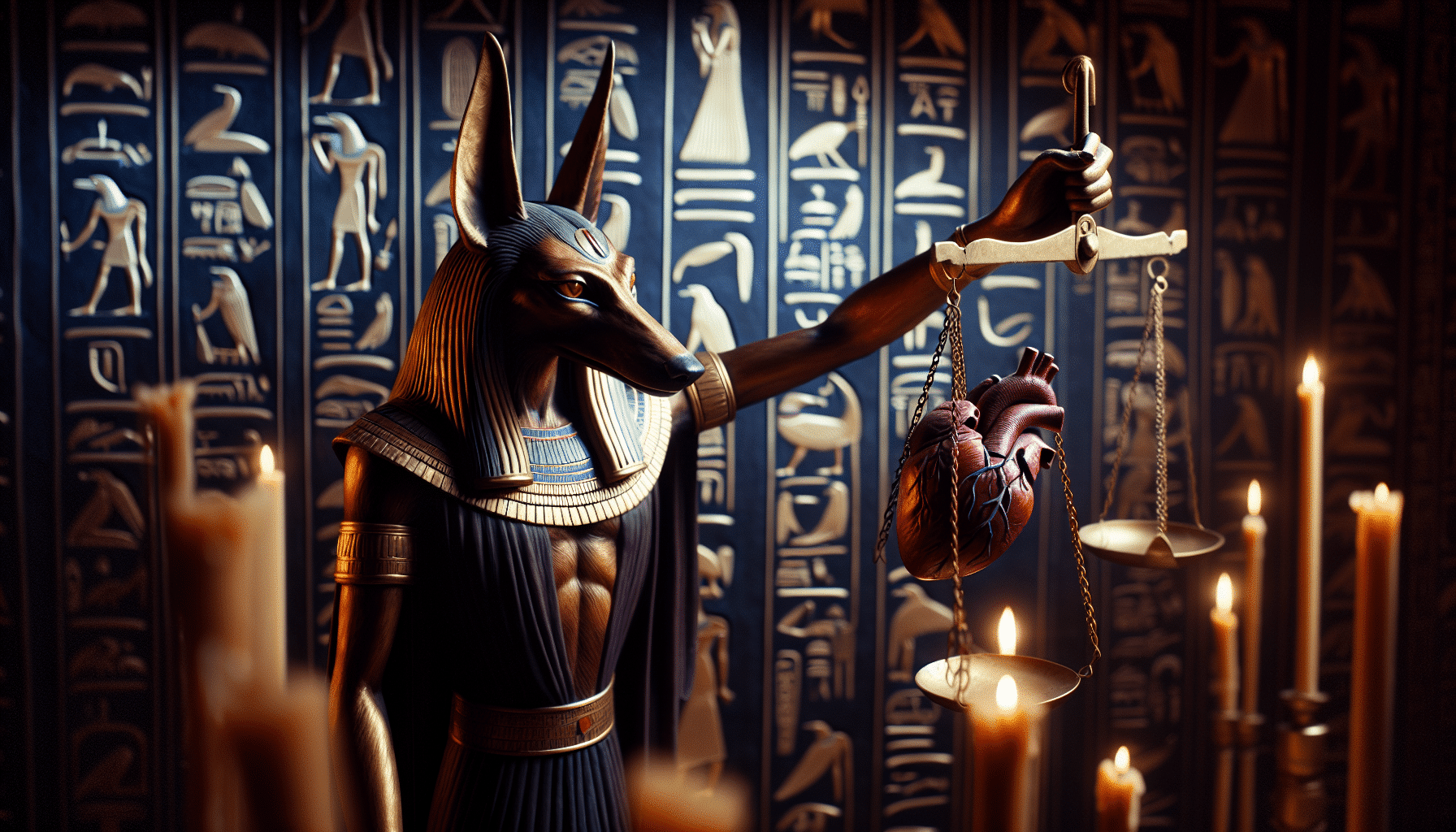
As you explore the fusion of ancient myth and divination, you’ll find that Egyptian deities like Thoth have left a significant mark on the Tarot’s history.
The imagery of Isis weaves profound symbolism throughout the cards, enriching your readings with layers of meaning.
Meanwhile, the archetypal figure of Anubis brings a unique perspective on life’s transitions and the afterlife within the Tarot narrative.
Thoth Tarot Origins
Within the rich tapestry of tarot history, the Thoth Tarot deck stands out for its profound incorporation of Egyptian mythology and deities. The deck’s origins are deeply entwined with Aleister Crowley’s influence and the Golden Dawn legacy.
Crowley, an occultist and member of the esoteric Hermetic Order of the Golden Dawn, envisioned a tarot that integrated the group’s mystical teachings with the pantheon of Egyptian gods. His Thoth Tarot, illustrated by Lady Frieda Harris, is a testament to this fusion, showcasing deities such as Thoth, the god of wisdom and writing, in its imagery.
You’ll find that each card in the deck resonates with the symbolic depth of ancient Egyptian lore, offering a unique lens through which to interpret the cards’ meanings.
Isis Symbolism
Many of the cards in the tarot deck feature Isis, the Egyptian goddess of magic and motherhood, whose symbolism can deepen your understanding of the readings. Here’s why you’ll find her influence meaningful:
-
Isis worship was central to ancient Egyptian religion, representing devotion and the power of healing – qualities that can reflect in your tarot sessions.
-
She’s often tied to the concept of resurrection through the Osirian cycle, symbolizing transformation and rebirth in your readings.
-
Isis embodies the nurturing aspect of the divine feminine, suggesting a need for compassion in your current situation.
-
Her magic and wisdom offer guidance, hinting at hidden knowledge or the need for introspection when she appears in your spread.
Embrace her timeless wisdom to unlock new layers in your tarot journey.
Anubis Archetypal Presence
You’ll find the enigmatic figure of Anubis, the jackal-headed god of the afterlife, woven into the tapestry of tarot as a symbol of protection and transition. Anubis iconography in tarot often represents the threshold between worlds, guiding souls and offering safe passage. His presence in a reading can signify transformation, indicating that you’re at a critical juncture in life’s journey.
Jackal symbolism, intrinsic to Anubis, embodies intelligence, resourcefulness, and keen instinct. These qualities are mirrored in cards that evoke Anubis’s spirit, urging you to trust your intuition as you navigate the unknown.
Embrace the wisdom of Anubis in your tarot practice, and let it illuminate the path through the mysteries that you seek to understand.
Check out our Tarot Cards & Oracle Decks here…
Greek Myths and The Chariot
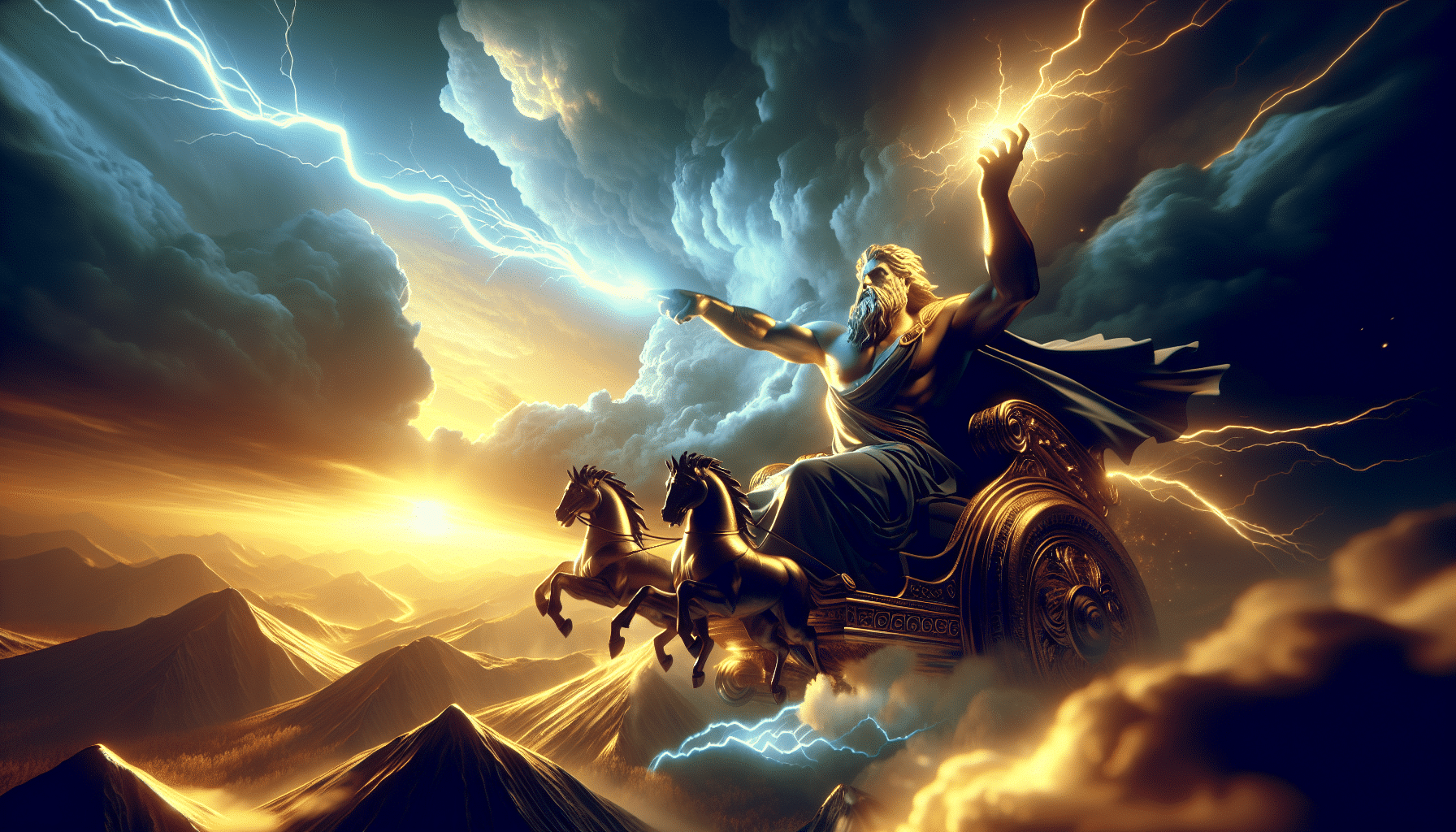
In your exploration of Tarot’s history, you’ll discover that the card of The Chariot is deeply intertwined with Greek mythology, exemplifying themes of conquest and triumph. The Chariot card often conveys a sense of control and willpower, much like the renowned Hercules strength. Ancient tales of Olympian charioteers further enrich the card’s symbolism, representing the journey towards achieving one’s goals through determination and skill.
To understand how Greek myths infuse The Chariot with meaning, consider the following:
-
Hercules’ Chariot: His legendary labors are metaphors for personal challenges, and his chariot represents the vehicle of success – overcoming obstacles with strength and courage.
-
Apollo’s Sun Chariot: Apollo, as the god of the sun, drives his chariot across the sky. This symbolizes clarity, vision, and enlightenment – qualities essential for victory.
-
Poseidon’s Chariot: Drawn by horses that represent fluidity and power, Poseidon’s chariot reflects mastery over emotions, an aspect of the self-control needed to triumph.
-
Athena’s Wisdom: Though not a charioteer, Athena’s strategic wisdom underpins the idea that success in The Chariot card comes not just from brute force, but from intelligent planning.
Embrace these narratives as you reflect on The Chariot’s role in your life, and see how ancient mythology can guide your path to personal victory.
Learn more with these tarot books here…
Roman Lore in The Lovers
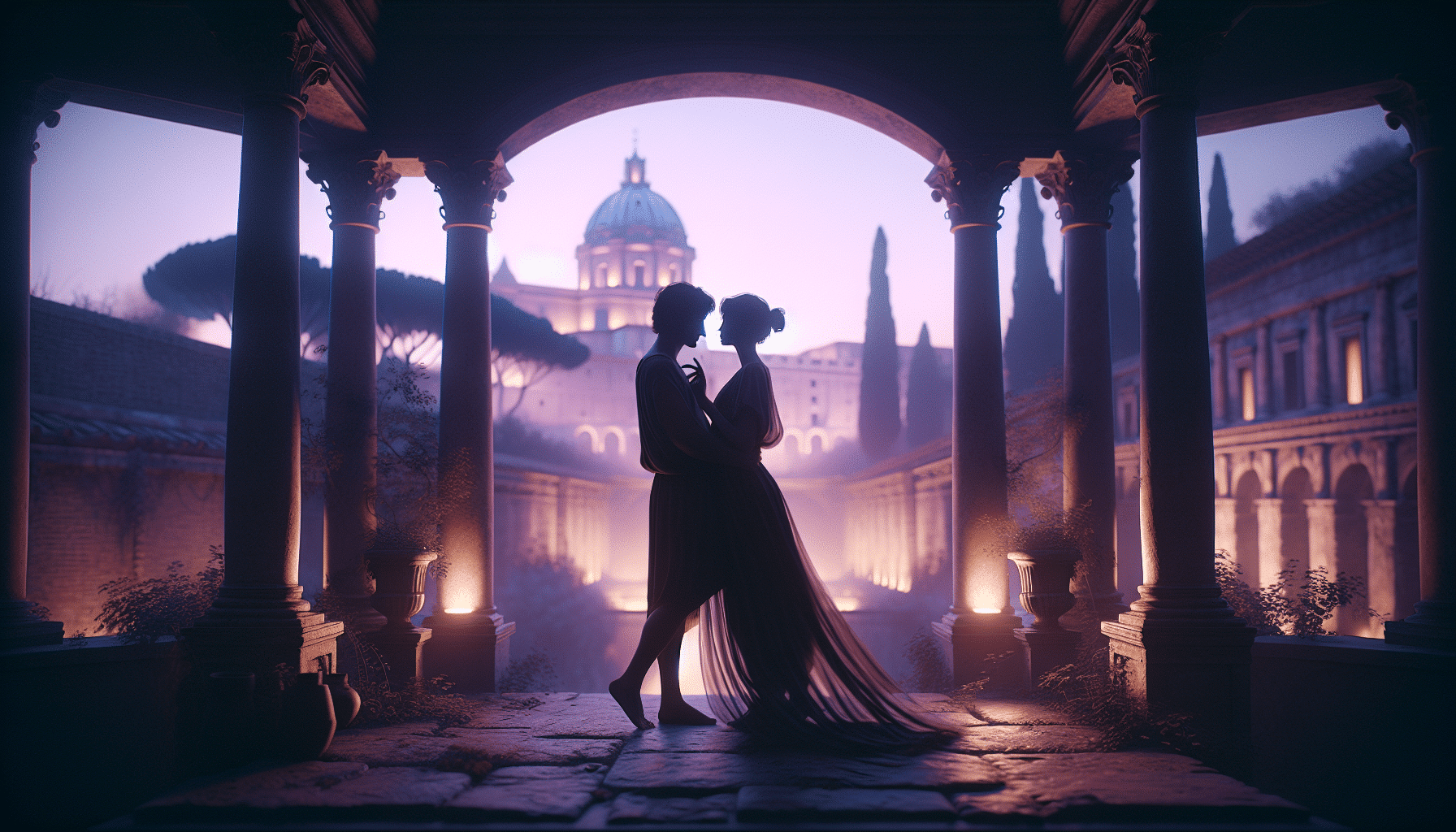
While exploring the Tarot’s Lovers card, you’ll find that Roman mythology offers profound insights into its themes of choice, passion, and partnership. The card embodies the essence of decision-making in love and relationships, a crossroads that’s been navigated by humanity since time immemorial.
Consider Cupid’s analogy in this context: the Roman god of desire, often depicted with a bow and arrow, represents the sudden and uncontrollable force of love. This aligns with the Lovers card, as it can signify a powerful, sometimes unexpected, attraction that demands attention and action. Cupid’s influence reminds you that love can be both a creative and a disruptive force, leading to pivotal moments much like the ones illustrated in the card.
Roman marriage customs also resonate with the Lovers card. These unions weren’t just romantic; they were strategic alliances that emphasized the importance of choice and the consequences that follow. In the Tarot, the Lovers can signal a moment when you’re faced with a significant commitment, echoing ancient Roman practices where partnerships were carefully considered for their long-term impact on family, wealth, and social standing.
Understanding these Roman connections enriches your interpretation of the Lovers, offering a lens through which you can view the card’s symbolism as timeless and universally human.
Learn even more secrets of history of tarot cards here…
Norse Runes and Tarot Links
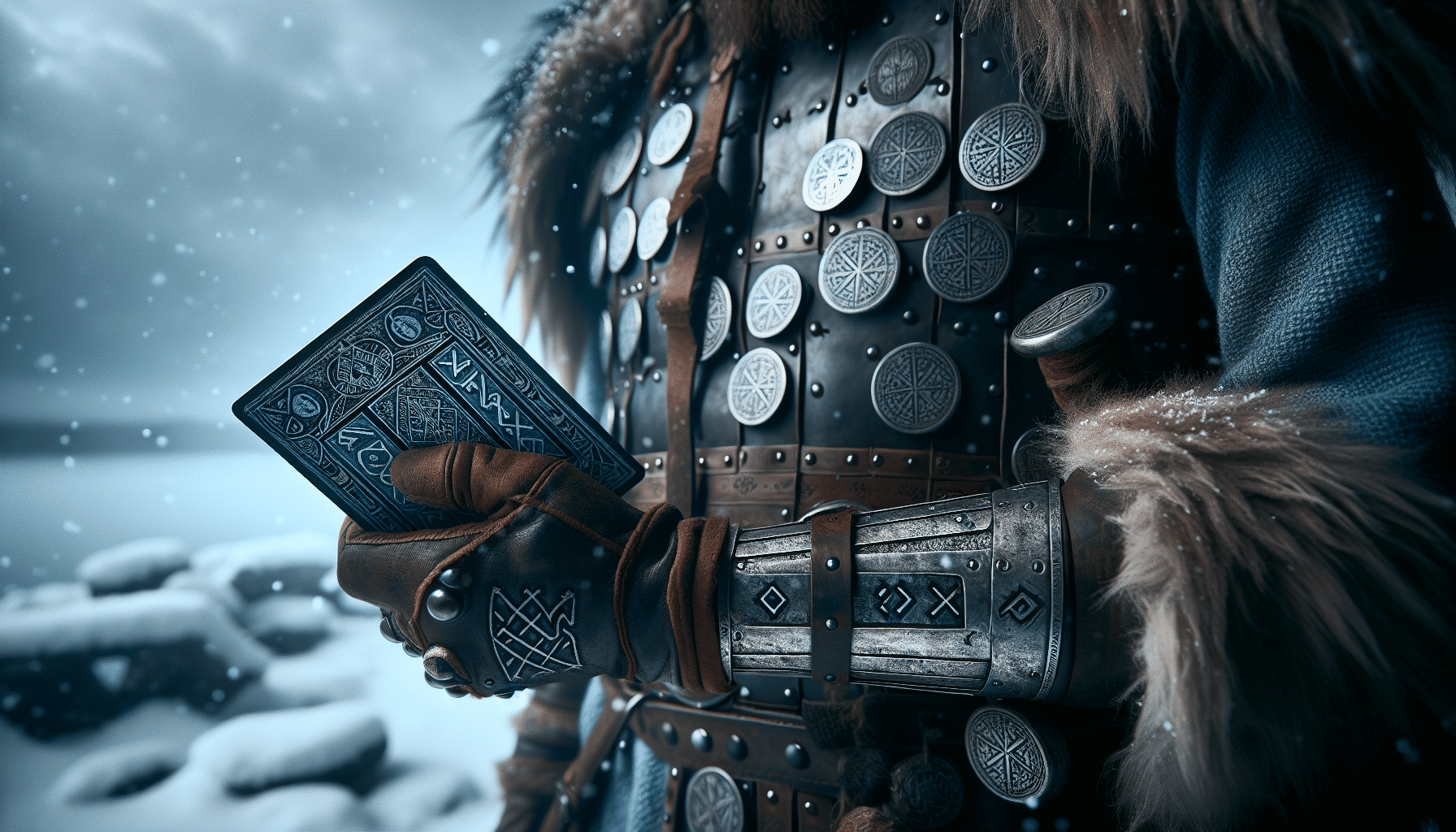
Delving into the Tarot, you’ll discover that the mysterious symbols of Norse runes have long intertwined with its rich tapestry of imagery and meaning. These ancient alphabets served not only as a written language but also as potent tools for runic divination, reflecting the depth of Viking spirituality in every stave and symbol.
Here’s how the runes and Tarot cards connect:
-
Historical Roots: Both Tarot and runes reach deep into history, with the runes dating back to the 2nd century AD. They’re steeped in the lore of the cultures that used them, offering insights into the spiritual and everyday life of the Vikings.
-
Symbolic Meanings: Each rune, much like Tarot cards, holds a universe of meaning, from prosperity (Fehu) to protection (Algiz). These symbols enhance Tarot readings by adding layers of Viking spiritual concepts.
-
Divination Practices: Runic divination involves casting runes and interpreting their positions and proximity, similar to laying out Tarot spreads to foresee the future or untangle life’s mysteries.
-
Personal Growth: Both systems offer a mirror to your inner world, helping you reflect on your path and personal evolution within the framework of Viking beliefs and the universal archetypes found in Tarot.
Celtic Influences on The Wheel
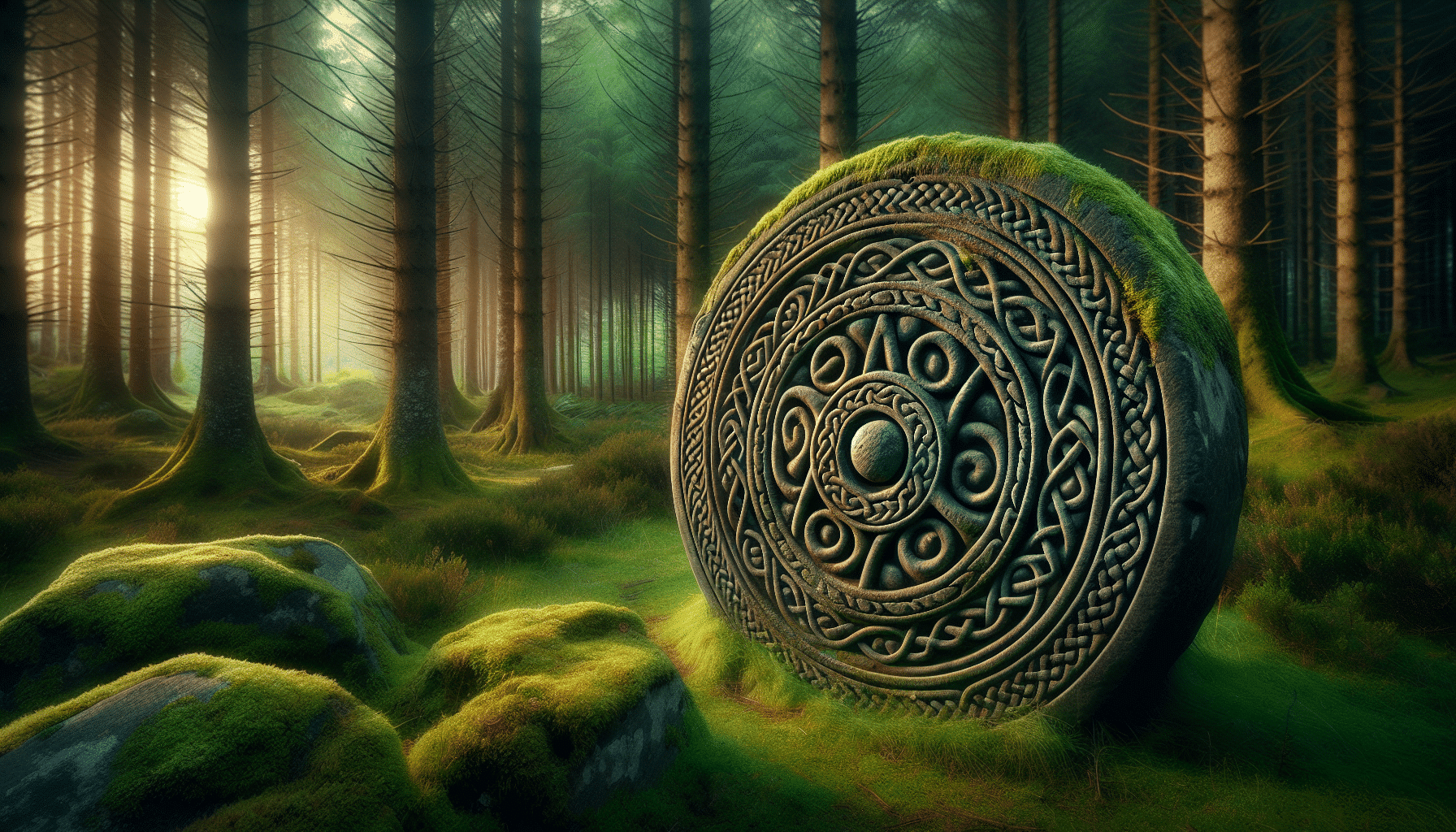
As you explore the Wheel of Fortune card, you’ll notice the profound impact of Celtic mythology, particularly through the enigmatic symbols of Ogham. The Wheel of Taranis, revered in ancient Celtic society, echoes in the card’s cyclical nature, symbolizing life’s ever-turning fate.
You’ll also see how Druidic practices, with their focus on the natural world and its cycles, are reflected in the intricate designs and meanings of The Wheel.
Symbolism in Ogham
Exploring the Ogham’s symbolism reveals its profound influence on the Tarot’s Wheel of Fortune, connecting you to ancient Celtic mythology. The Druidic alphabets, often associated with Ogham divination, hold significant meaning within the mystical world.
Here’s what you need to know about the Ogham’s impact:
-
Each Ogham symbol corresponds to a tree or plant, providing layers of nature-based meanings.
-
The Ogham’s linear script is akin to the cyclical nature of the Wheel, symbolizing life’s perpetual motion.
-
Druids used Ogham for divination, much like the predictive aspect of the Tarot.
-
The Ogham’s deep roots in Celtic culture enrich the Wheel’s representation of fate and fortune.
These connections offer a richer understanding of the Wheel’s symbolism, infusing your Tarot readings with ancient wisdom.
Wheel of Taranis
You’ll find the Wheel of Taranis, a testament to Celtic mythology’s influence on Tarot, shares a symbolic kinship with the Ogham’s cyclical nature and divinatory practices. The wheel, often featuring Taranis iconography, represents the dynamic balance of life’s forces and the inevitable changes that come with each turn.
In Tarot, this concept is vividly captured in the Wheel of Fortune card, echoing the unpredictable nature of fate and fortune.
Moreover, Celtic astrology, which intricately weaves together the natural world and the cosmos, resonates with the Tarot’s philosophical threads. The Wheel of Taranis embodies this connection, suggesting that understanding the cycles of nature can offer profound insights into one’s journey and destiny.
Druidic Practices Reflected
In your exploration of Tarot’s history, you’ll see that Druidic practices, particularly those involving nature and the esoteric, heavily influence the symbolism within the Wheel of Fortune card. Here’s how:
-
Stonehenge Rituals: The card’s cyclical nature echoes the solar and lunar cycles celebrated at Stonehenge.
-
Seasons of Change: Just as Druids honored the changing seasons, the Wheel signifies life’s inevitable transitions.
-
Celtic Shamanism: The mystical elements of the card may draw from shamanic journeys, a practice central to ancient Celtic spirituality.
-
Animistic Elements: Druids believed in the spiritual essence of all things, a concept that permeates the Wheel’s imagery, suggesting an interconnected universe.
Understanding these connections offers a richer perspective of the Tarot and its profound ties to ancient wisdom.
Hindu Deities in The World
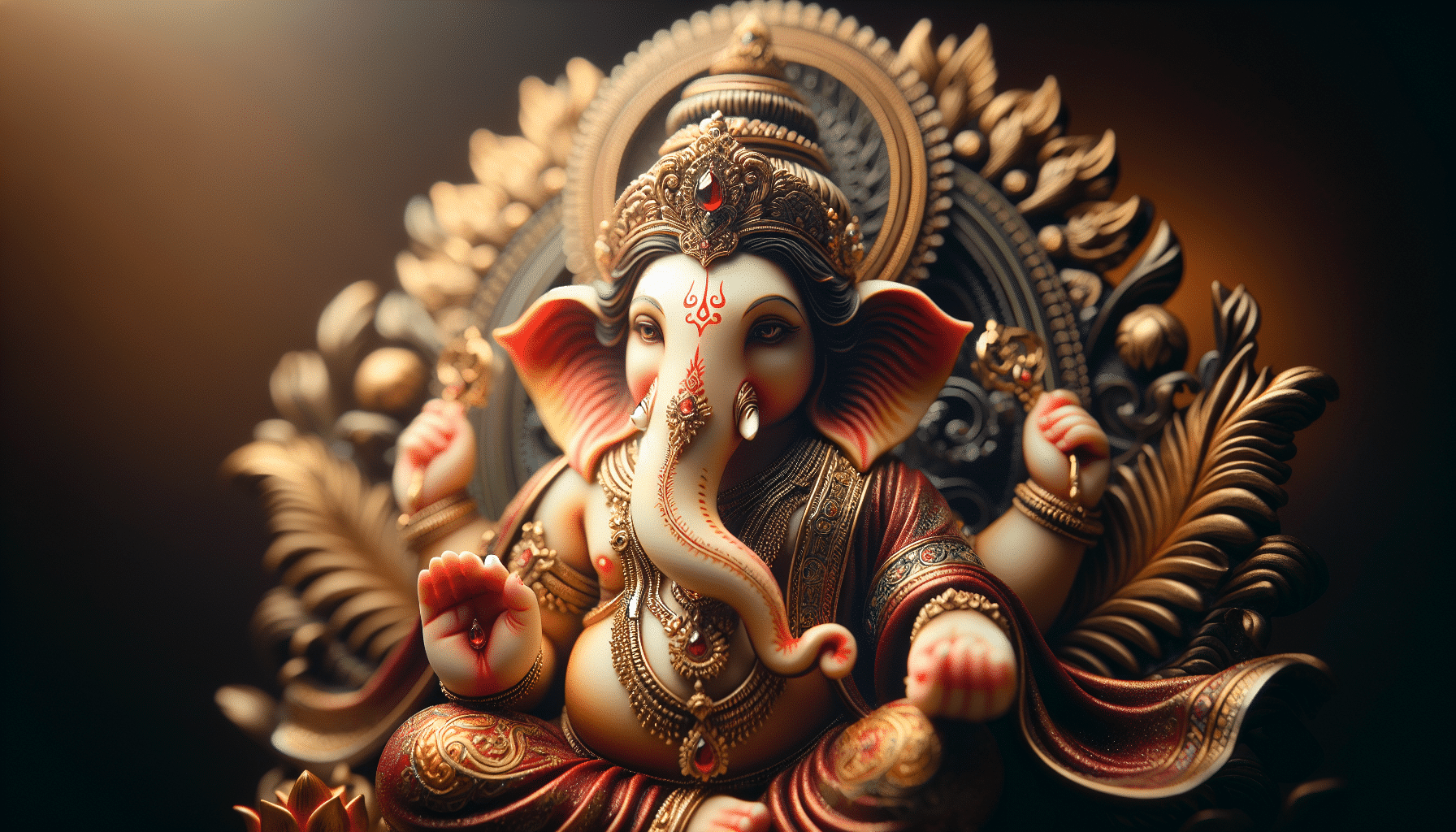
Tarot cards often embrace the rich tapestry of Hindu mythology, reflecting deities such as Shiva and Lakshmi in their intricate symbolism. As you delve into the cards, you’ll find that the principles of Vedic astrology and narratives like Krishna’s journey resonate within the archetypes depicted in the deck. These stories aren’t just ancient tales; they’re keys to understanding the cosmic dance of the universe and your place within it.
Let’s explore how the Tarot portrays these powerful Hindu deities:
| Deity | Tarot Card | Emotional Essence |
|---|---|---|
| Shiva | The Hermit | Seeking inner wisdom and understanding through meditation. |
| Lakshmi | The Empress | Abundance, beauty, and the nurturing of creative ventures. |
| Krishna | The Chariot | The triumph of will and the mastery of one’s own destiny. |
As you connect with these cards, you’re not just predicting the future; you’re tapping into a profound well of philosophy and spirituality that has guided countless souls through life’s journey. Each card doesn’t just tell a story; it invites you to feel the divine play of creation, preservation, and transformation. So, as you draw your next card, remember that you’re engaging with a legacy that bridges the mystical and the mundane.
Conclusion
You’ve voyaged through visions of venerable myths mingled with tarot’s tapestry. From the Fool’s fearless foray to the World’s wide wisdom, ancient archetypes have adorned your adventure.
You’ve glimpsed Greek glories, savored Norse secrets, and celebrated Celtic cycles. Whether you’re a tarot enthusiast or a mythology maven, may these timeless tales transform your readings, infusing each card with the enchantment of eons.
Carry these classic chronicles close, and let the legends lead your way.

About The Author – Allen Hill
Allen Hill, the force behind Unknown Truth Tarot, has a YouTube following 6-times bigger than the population of his hometown, Miamisburg, Ohio. From his spiritually rich blog on Tarot and crystals to his role as CEO of The Unknown Truth Tarot Metaphysical Shop, Allen’s passion for the metaphysical shines through.
A master Tarot reader and “crystal junkie,” Allen is also a devoted dad to Dylan, 10, and Destiny, 24. When he’s not immersed in the world of Tarot and crystals, he enjoys poker and video gaming sessions, often humorously outplayed by Dylan.
Follow Allen on Twitter, Instagram, Facebook, TikTok, and subscribe to his Unknown Truth Tarot YouTube channel to join him on a journey of spiritual growth and self-discovery.

